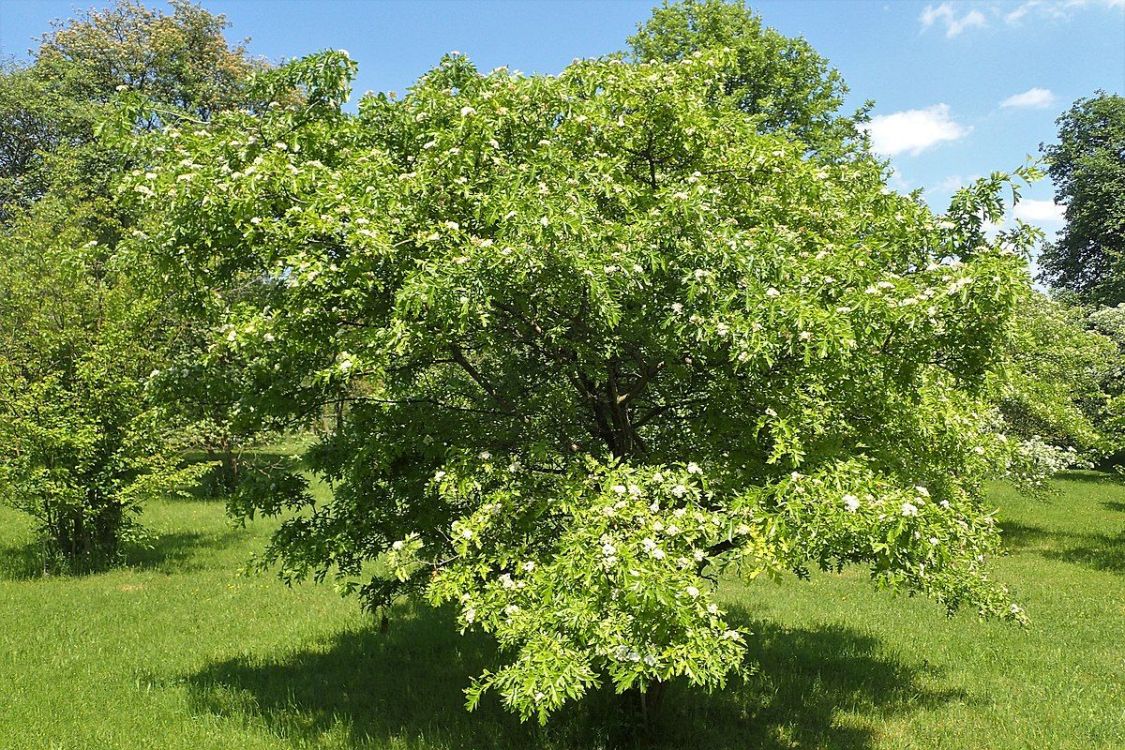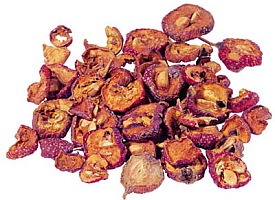 Crataegus
pinnatifida, C. cuneata 山
楂 Shān zhā
Chinese hawthorn Family:
Rosaceae
Crataegus
pinnatifida, C. cuneata 山
楂 Shān zhā
Chinese hawthorn Family:
Rosaceae
PART USED: Fruit
FUNCTIONS
GROUP: Digestives and Evacuants
1. Corrects digestion. Promotes digestion.[1,5,6] Strengthen the Stomach and improve digestion, relieve diarrhea and dysentery. Corrects digestion and transform accumulation. Aids digestion. Stops diarrhea.[1]
2. Promote Blood circulation.[1] Disperse blood stasis.[5,6] Lower blood pressure and the level of blood lipids. Disperse blood clots.
INDICATIONS
1. Indigestion,[1,2,3,4] especially over feeding in infants, and overconsumption of meats.[2,6] Acid reflux. Infantile marasmus (wasting due to malnutrition).[1] Adominal swelling.[5,6]
2. Diarrhea and dysentery,[1] especially for those caused by over eating and drinking. Hemafecia.[5,6]
3. Blood stasis manifested as anemia, postpartum abdominal pain with lochiostasis, angina pectoris, polyp of vocal cord. Inguinal hernia.[1,5,6] Swelling of testis with bearing down pain, hepatosplenomegaly, and cyst of the breast. Menstrual cramps.[1] Hypertension and hyperlipidemia.
4. Resolve sputum, anorexia. Lumbago.[5,6] Mucous discharge.[5,6] Neck pain after childbirth.[5,6]
5. Expel tape worms.[5,6]
PATENT COMBINATIONS
CONTRAINDICATIONS- Weak Spleen/Stomach.[3] Avoid if suffering from constipation.[2] Constipation due to internal Heat or those who have excessive gastric acid.[6]
PREPARATIONS: Decoction. Fruits and roots 6-12 g.[1,4] Dried fruit.[3] Dried fruit is prepared by soaking hawthorn fruit in boiling wate for less than 1 minute; slice the fruits and lay them in the sun to dry.[6]
Decoction of 30-60 g for anemia, angina pectoris, hypertension and hyperlipidemia.[4]
Decoction of 30-60 g for gargling for polyp of vocal cord.[4]
Standardized extract 18.75% oligomeric proyanidins 60 mg 3 X/day or 80 mg 2 X/day.[2]
Standardized 2.2% flavonoids 100-300 mg 3 X/day.[2]
Hawthorn Charcoal - Heat the dried flakes over a hot plate until they turn to charcoal.[2] Good for diarrhea due to acute gastroenteritis or dysentery, or in small children.[2]



- Hawthorn fruit wine- Mix together the following ingredients and marinate for 10 days; 250 g hawthorn slices, 250 g fresh longans, 30 g red dates, 30 g brown sugar, and 4.5 cups rice wine.[6]
- Pain caused by excessive fatigue, muacular pain, and arthritis pain, flying spots in front of the eyes, lumbago, and pain in thigh in the elderly- Drink 30-60 g hawthorn fruit wine at every bedtime.[6]
- Fry Hawthorn slices until they look like charcoal to make hawthorn fruit charcoal.[6]
- Cure scurvy- Boil in water 60 g Hawthorn fruit slices with an equal amount fresh or dried chestnuts until very soft; add 30 g sugar and stir thoroughly. Drink the juice once a day, first thing in the morning on an empty stomach.[6]
- Hernia of the small intestine- Boil 31 g Hawthorn slices with water; stir in 1.5 g Fennel powder. Drink the juice in the morning and evening.[6]
- Hypertension, high level of blood fat, and corinary heart disease- Boil 15 g Hawthorn fruit slices in water and drink as tea on a long-tern basis.[6]
- Relieve abdominal lpain caused by acute and chronic gastritis, and dysentery- Grind 6 to 9 g hawthorn fruit charcoal into powder. Take the powder with warm water, once a day.[6]
- Oral administration to stop diarrhea in children- Boil 3 g hawthorn carcoal with 6 g hawthorn fruit slices; drink the juice. Or crush 5 hawthorn fruits and squeeze out the juice to mix with a pinch of hawthorn fruit carcoal.[6]
- Correct indigestion, abdominal swelling, and abdominal pain- Crush 2 to 3 fresh hawthorn fruits and squeeze out the juice to drink; or boil 2 to 3 hawthorn fruits with 6 g dry orange peels; drink the juice.[6]
NOTES: Hawthorn fruits can effectively digest fat and prevent it from entering into the blood vessels by removing it through the bowel movements. Indeed, the fruits are so s effective in softening hard substances, the Chinese people use it to cook tough olden chickens. when hawthorn fruits are used in the cooking water, the gouh chickens become soft and tender- an indication of the tenderizing power of this fruit. Another example, when hawthorn fruits are used to cook fish, even the fish bones will become tender.[6]